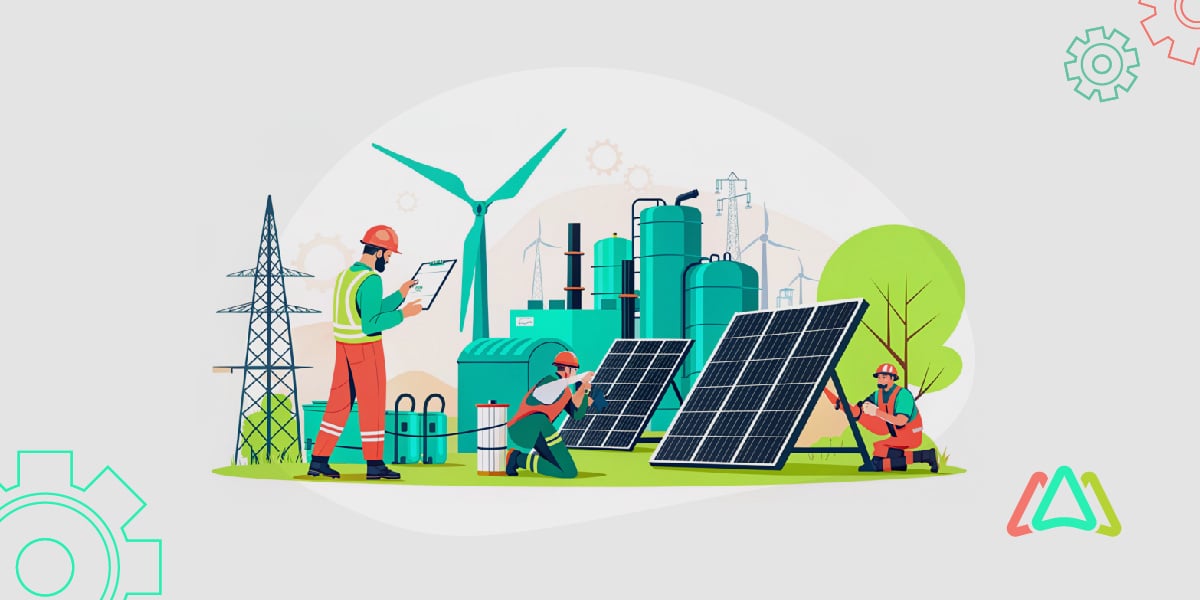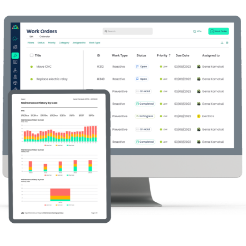
The Role of CMMS in Sustainable Facility Management
As sustainability becomes a global focus, facility management has a unique opportunity to lead the way. A recent study reveals facilities are responsible for around 39% of global CO2 emissions annually, highlighting the critical need for efficient resource management. Yet, without the right tools, achieving sustainability can feel like an uphill battle.
This is where Computerized Maintenance Management Systems (CMMS) are instrumental. By streamlining maintenance, tracking energy use, and minimizing waste, CMMS transforms facilities into hubs of efficiency and environmental stewardship. From cutting operational costs to aligning with global sustainability goals, CMMS delivers measurable impact.
In this article, we explore how CMMS software enhances sustainability efforts and prepares facilities to meet future environmental challenges.
What is CMMS, and How Does it Work?
A CMMS is software that centralizes maintenance data. It helps facility managers schedule tasks, track work orders, and monitor assets efficiently. CMMS automates routine tasks and enables preventive maintenance, reducing downtime, emergency repairs, and operational costs. It also supports sustainability by ensuring equipment runs efficiently, consumes less energy, lasts longer, and produces less waste.

Why is Sustainability Important?
Sustainability is essential as industries face increasing pressures to address climate change, resource depletion, and environmental harm. Adopting sustainable practices helps reduce environmental impact by conserving resources, cutting energy consumption, and minimizing waste. Beyond environmental benefits, sustainability also drives financial savings. Efficient energy use and properly maintained assets lower utility costs and extend the life of equipment, reducing the need for costly repairs or replacements.
Sustainability also enhances a facility’s reputation, as customers, employees, and stakeholders increasingly prioritize eco-friendly practices. It strengthens brand value, promotes trust, and ensures compliance with evolving regulations. In today’s world, sustainability is not just a trend; it’s an essential factor for long-term success. Facilities that embrace it can save costs, stay competitive, and contribute to a healthier planet.
Challenges in Achieving Sustainable Facility Management Without CMMS
Achieving sustainable facility management without a CMMS is difficult due to inefficiencies. Without data-driven insights, facility managers rely on guesswork and miss patterns in energy use and maintenance needs. Reactive maintenance, addressing issues only after breakdowns, wastes resources and increases costs. Manual tracking of energy use often leads to inefficiencies, such as running systems unnecessarily or overlooking energy-draining equipment, driving up emissions and costs. The wasted energy, excessive repairs, and poor resource management undermine sustainability efforts and increase environmental impact.
How CMMS Supports Sustainable Facility Management
A CMMS plays a vital role in promoting sustainable facility management by addressing key areas that contribute to waste reduction, energy efficiency, and the overall lifespan of assets. Here’s how it supports sustainability in different aspects of facility operations:
Proactive and Preventive Maintenance
CMMS helps facilities shift from reactive maintenance (fixing issues as they arise) to proactive and preventive maintenance. By scheduling regular check-ups and routine inspections, a CMMS minimizes unplanned downtime and ensures that equipment runs at optimal efficiency. This not only extends the lifespan of assets but also reduces the frequency of repairs, cutting down on waste from early replacements. The result is fewer resources spent on repairs and replacements, which directly contributes to sustainability goals.
Energy Management Integration
Energy consumption is one of the biggest contributors to a facility’s environmental footprint. CMMS enables energy management integration, allowing facility managers to track and analyze energy use across different systems. By identifying inefficiencies, such as systems running when they’re not needed, CMMS helps reduce energy waste. Furthermore, when integrated with IoT-enabled devices, CMMS can provide real-time monitoring, giving managers immediate insights to adjust settings and further optimize energy consumption. This leads to reduced carbon emissions and lower utility costs—key components of sustainable operations.
Waste Reduction
A well-maintained facility runs more efficiently and minimizes waste. CMMS software supports waste reduction through features like optimized inventory management. By tracking materials, equipment, and supplies, CMMS helps prevent overstocking and spoilage, ensuring that resources are used wisely. Additionally, CMMS software helps streamline maintenance schedules, ensuring that equipment is only used when necessary and that downtime is kept to a minimum. This efficient approach reduces waste and ensures that resources, both human and material, are not squandered.
Compliance with Green Certifications
CMMS can be an invaluable tool for facilities aiming to achieve green certifications like LEED, BREEAM, or ISO 14001. It tracks key metrics such as energy use, water consumption, and waste management, helping facilities stay on track with certification requirements. By ensuring that maintenance practices align with sustainability standards, CMMS helps facilities not only meet but exceed environmental goals, boosting their reputation as environmentally responsible organizations.
In these ways, a CMMS supports day-to-day operations and directly contributes to long-term sustainability efforts. It helps facilities reduce their environmental impact while improving efficiency and cutting costs.
Future Trends: Emerging CMMS Features to Enhance Sustainability
The future of sustainable facility management is closely tied to advancing CMMS technologies, with emerging features designed to enhance efficiency and sustainability:
AI-Driven Maintenance Predictions
AI in CMMS enables predictive maintenance by analyzing data to address issues before they occur. This reduces unplanned downtime, extends asset life, and conserves resources, promoting sustainable operations.
Deeper IoT Integrations for Carbon Tracking
IoT devices integrated with CMMS provide real-time data on energy use and carbon footprints. This empowers facility managers to identify inefficiencies, reduce emissions, and make smarter, greener decisions.
Integration with Renewable Energy Systems
CMMS now connects with renewable energy systems, tracking energy production and optimizing usage. This reduces reliance on non-renewable resources and ensures efficient management of solar, wind, or other sustainable energy sources.
Alignment with Smart Buildings
As buildings adopt smart technologies, CMMS will manage systems like HVAC, lighting, and energy storage to maximize efficiency and reduce waste. This integration supports sustainable smart building goals and enhances resource management.
These trends position CMMS as a cornerstone for sustainable, efficient, and future-ready facility management.
Benefits of Using CMMS for Sustainable Facility Management
Using a CMMS for sustainable facility management offers key benefits that enhance both operational efficiency and long-term sustainability goals:
Enhanced Operational Efficiency and Reduced Costs
CMMS automates maintenance schedules, tracks asset performance, and reduces downtime, improving efficiency. This leads to cost savings through less energy waste, fewer emergency repairs, and optimized resource use, ensuring smoother, more economical operations.
Improved Stakeholder Confidence with Sustainable Practices
Adopting CMMS shows a commitment to green practices, which boosts stakeholder confidence. Clients, investors, and employees increasingly value sustainability, and CMMS helps businesses demonstrate their eco-friendly operations, enhancing their reputation.
Long-Term ROI Through Energy Savings and Better Resource Management
In 2022, U.S. consumers spent $1.7 trillion on energy — 6.7% of GDP and a 30% increase from 2021. This rising cost underscores the urgency of efficient energy management. CMMS software helps facilities cut energy consumption, extend asset life, and minimize waste by identifying inefficiencies. These savings not only reduce operational costs but also align with sustainability goals, making CMMS a smart, future-proof investment.
How to Choose the Right CMMS for Sustainable Facility Management
When selecting a CMMS for sustainable facility management, it’s important to focus on features that support both current and future sustainability goals. Here are the key aspects to consider:
Custom Monitoring and Reporting
Look for a CMMS with robust custom monitoring and reporting capabilities. These tools allow you to configure data tracking to include energy usage, operational inefficiencies, or other metrics that align with your sustainability goals. By generating tailored reports and analyzing trends, you can pinpoint areas for improvement, optimize resource use, and ensure your facility operates efficiently.
Integration Options with Existing Facility Systems
A good CMMS should integrate seamlessly with your existing facility systems. Integration capabilities ensure that you can easily consolidate data from different sources and manage operations from a single platform, improving overall efficiency and sustainability.
Scalability for Future Sustainability Goals
As sustainability goals evolve, your CMMS should be able to grow with them. Choose a scalable system capable of adding new features, expanding functionality, and supporting your team with more complex operations as your facility’s needs change over time.
Conclusion: Paving the Way for a Greener Future with CMMS
In conclusion, CMMS is a game-changer for sustainable facility management. It enables streamlined operations, reduced waste, and optimized energy use. By delivering data-driven insights and proactive maintenance, CMMS helps facility managers lower their environmental impact while improving efficiency.
As sustainability takes center stage, adopting a CMMS is a practical step toward achieving long-term green goals. Facility managers have the opportunity to transform their operations and contribute to a greener future. Start your journey toward sustainability today by embracing CMMS.
TABLE OF CONTENTS
Keep Reading
The longest U.S. federal government shutdown to date lasted 43 days, beginning on October 1, ...
5 Dec 2025
Every maintenance professional faces it sooner or later — that critical time when an aging ...
18 Nov 2025
The term 'best' is often used loosely, without a clear understanding of its context or ...
14 Nov 2025
In the not too distant past, maintenance strategies have been defined by reaction—fixing ...
13 Nov 2025
Tax season is the time of year that often sends a ripple of anxiety through many of us. The ...
11 Nov 2025
Selecting a Computerized Maintenance Management System (CMMS) can, at first glance, be an ...
4 Nov 2025
In healthcare facilities, equipment uptime involves more than achieving operational ...
31 Oct 2025
Companies are subject to economic ups and downs, also known as economic volatility. Today, ...
30 Oct 2025
Maintenance challenges are a constant struggle, with unplanned downtime costing manufacturers ...
27 Oct 2025
Last winter, a maintenance technician at a U.S. paper mill ignored a predictive alert that ...
10 Oct 2025
Many organizations proudly say they “have a CMMS,” but ownership alone doesn’t equal ...
9 Oct 2025
Every maintenance team is under pressure to do more with less. Unplanned downtime is often ...
7 Oct 2025
The implementation of simple, yet powerfully effective, checklists has repeatedly ...
3 Oct 2025
In manufacturing, every second counts. When production stops, whether due to scheduled ...
2 Oct 2025
The increasing cost of maintenance, lack of accountability, and siloed systems leave many ...
30 Sep 2025
Preventive maintenance is one of those things maintenance teams know they need to do, but it ...
26 Sep 2025
Public services are essential to daily life. The provision of safe roads, functional transit, ...
25 Sep 2025
For most manufacturing facilities, a major focus of their maintenance teams revolves around ...
24 Sep 2025
Have you ever tried explaining to the CEO why the production line has been down for hours ...
18 Sep 2025
Over the past few decades, the hotel industry has undergone a dramatic transformation. ...
16 Sep 2025






